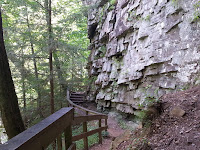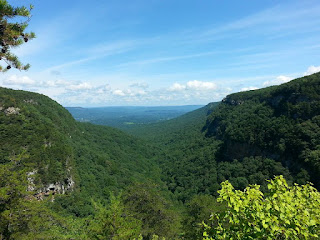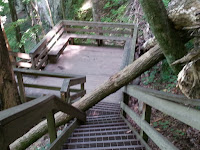The north Georgia mountains are full of hidden adventures and secret opportunities. That's why I often find it more fun to drive through the area without a plan and let adventure find me. One of the most unique and is hidden away in northwest Georgia, not far from Rock City. Unknown to most Georgians, a river cuts through the famous Lookout Mountain, carving an actual canyon along its way. One of only three in Georgia, Cloudland Canyon is widely considered to be the most beautiful of the trio. From the top, visitors can enjoy across the canyon extending to a valley, with thick forests below. At first glance, this appears to be all the canyon has to offer.
 However, a 1500 foot hike down the stairs reveals an entirely new world. There is much more to be discovered, and it doesn't take long to find. For me, I chose to follow the waterfall trail down the east wall of Cloudland Canyon. As I began to descend, I was immediately greeted by unique rock formations and small streams trickling along the mountainside. As the wall became more steep, its edge's features also grew more jagged. The walkway wraps tightly around them, putting hikers within arms-length of the canyon's rich geological history. The wall looks like a climber's dream, though I'm sure scaling it would (unfortunately) be frowned upon by park officials.
However, a 1500 foot hike down the stairs reveals an entirely new world. There is much more to be discovered, and it doesn't take long to find. For me, I chose to follow the waterfall trail down the east wall of Cloudland Canyon. As I began to descend, I was immediately greeted by unique rock formations and small streams trickling along the mountainside. As the wall became more steep, its edge's features also grew more jagged. The walkway wraps tightly around them, putting hikers within arms-length of the canyon's rich geological history. The wall looks like a climber's dream, though I'm sure scaling it would (unfortunately) be frowned upon by park officials. Continuing down, I noticed that 2 segments of the path were blocked by the same fallen tree. Several hikers decided to turn around, but it was easy enough to climb over. As I continued to descend, the rock formations grew in size and prominence. The roaring of the river also became louder. A sign reveals waterfalls at each end. The canyon narrows to my left, so I head that way first. A short hike over some rocks and through the woods revealed a waterfall over 80 feet high.
Continuing down, I noticed that 2 segments of the path were blocked by the same fallen tree. Several hikers decided to turn around, but it was easy enough to climb over. As I continued to descend, the rock formations grew in size and prominence. The roaring of the river also became louder. A sign reveals waterfalls at each end. The canyon narrows to my left, so I head that way first. A short hike over some rocks and through the woods revealed a waterfall over 80 feet high.Past that, I continue my hike to the west wall of Cloudland Canyon. I found an unusual rock formation with small streams of water flowing down its ridged edges. Beyond that, though, this section appears to be less scenic, though it does offer a view of my strarting point from the top. There's also a small cave along the trail, though it won't fit more than 2 or 3 people.
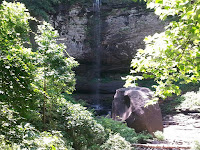 Back at the bottom, I begin to discover the features that really make Cloudland Canyon famous: the waterfalls. The trails run along a creek on the canyon floor. Hemlock Falls is among the first to greet visitors, though it was running a little light today.
Back at the bottom, I begin to discover the features that really make Cloudland Canyon famous: the waterfalls. The trails run along a creek on the canyon floor. Hemlock Falls is among the first to greet visitors, though it was running a little light today.  Continuing down, the trail leads to a grated pass high above the creek before descending to the next waterfall. Tip: if you're afraid of heights, don't look down on this particular segment of the walkway. It's a fairly high drop, and the grates are spaced enough to see the bottom pretty well. After the descent, the trail continues to the left of the falls. To reach it, a bit of a climb is required. I'm not entirely sure how park rangers feel about people climbing down there, but several others (including children) had already done so. At the bottom, it is entirely possible to walk through or under the waterfall, though the rocks are slippery. The pool forms a smaller fall just beyond before continuing down the canyon.
Continuing down, the trail leads to a grated pass high above the creek before descending to the next waterfall. Tip: if you're afraid of heights, don't look down on this particular segment of the walkway. It's a fairly high drop, and the grates are spaced enough to see the bottom pretty well. After the descent, the trail continues to the left of the falls. To reach it, a bit of a climb is required. I'm not entirely sure how park rangers feel about people climbing down there, but several others (including children) had already done so. At the bottom, it is entirely possible to walk through or under the waterfall, though the rocks are slippery. The pool forms a smaller fall just beyond before continuing down the canyon. 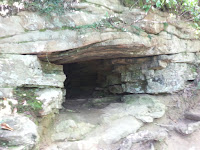 A bit further down, the river forms a smaller, more secluded waterfall can be found between a few large rocks. Beyond that, the trail becomes a bit less scenic before it eventually runs into Bear Creek at the cross-way of the canyon. I decided not to venture that far for now, though I'm sure that I will have another chance to explore the area sometime this autumn.
A bit further down, the river forms a smaller, more secluded waterfall can be found between a few large rocks. Beyond that, the trail becomes a bit less scenic before it eventually runs into Bear Creek at the cross-way of the canyon. I decided not to venture that far for now, though I'm sure that I will have another chance to explore the area sometime this autumn. 
